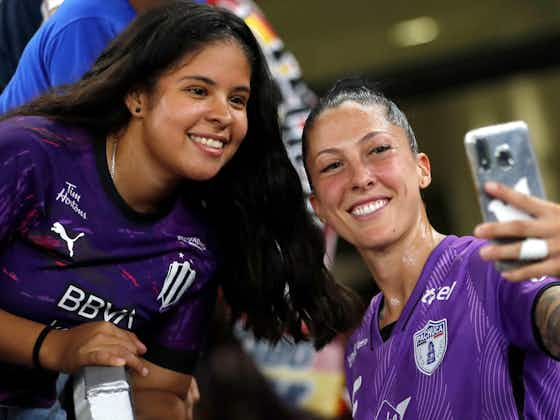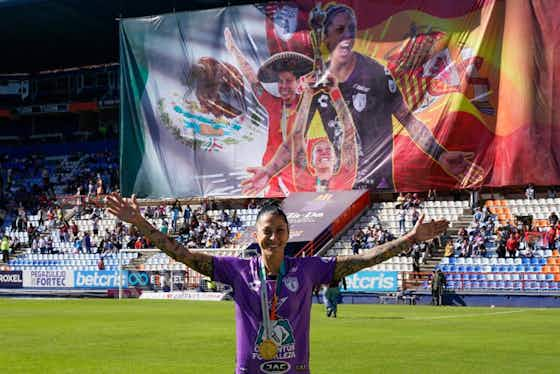The Guardian
·4 October 2023
Hermoso joining Liga MX Femenil was huge, but inequalities still remain

In partnership with
Yahoo sportsThe Guardian
·4 October 2023

After weeks and weeks of being the face of world news, Jenni Hermoso is now back doing what she prefers to do: playing football. The fallout from the World Cup final, when the Spanish FA president, Luis Rubiales, grabbed Hermoso by the head and planted an unsolicited kiss on her lips, is far from over but with 9,000 km between her Mexican club, Pachuca, and Madrid, there is at least some room to breathe.
On Sunday, Pachuca hosted América in Liga MX Femenil, a long-awaited game between last season’s top two sides. América took a two-goal lead but Hermoso led the comeback, supplying two assists as Pachuca ran out 4-2 winners at the Estadio Hidalgo.
It was last year that Hermoso swapped Barcelona for Pachuca, a decision that was questioned by many. A player at the peak of her powers, top scorer in the Spanish league five times between 2015 and 2021, became the blockbuster signing for a league that began only in 2017 and was still trying to break into the upper echelons of the women’s game.
“For us Mexicans, it was a surprise that someone who’d won the Champions League would come to play here,” said Naim Gallegos, who runs the women’s football website Futbo13ra. “It caused quite a stir. It’s become a running joke here that the Liga MX Femenil is ‘the exotic league’ – because that’s how they referred to it in Spain.”

In its short existence, the Liga MX Femenil has transformed women’s football in Mexico. Before, the best Mexican players had to leave the country to play at the highest level, whether in the United States or Europe. Now, the current has switched direction: foreign players are coming to Mexico.
Initially, for the sake of player-pool development, only Mexican players were allowed in the league. That changed in 2021 after which Hermoso signed for a rumoured six-figure salary. Argentina’s all-time top scorer, Mariana Larroquette, joined León; Jermaine Seoposenwe, who starred for South Africa at the 2022 Africa Cup of Nations, arrived to play for FC Juárez.
The moves created buzz for the league. It helps that, unlike games in many other leagues, all Liga MX Femenil games are televised, and many are played in proper stadiums. In 2022, the average attendance was above 2,000. Finals in the legendary Estadio Azteca, in Mexico City, have had around 60,000 fans.
“The Liga MX Femenil gets a lot of media time,” said Gallegos. “It’s one of the most followed leagues on social media, too. They’ve found a way to bring the football to their audience, and the popularity has shot up.”
But this hasn’t necessarily translated into good salaries for all the players. There are huge wage differences within the women’s game, with many players barely earning enough to get by as professional athletes.
In the early years of the league most clubs had a salary cap to try to control their finances and to make their projects sustainable but it still left a lot of players on small wages. “We’re talking about salaries of about $100 a month,” said Gallegos. “Imagine trying to be an athlete with that? Impossible.”

Things have improved, but Gallegos wants there to be a minimum salary that is enough to live off. She says there are still lots of players earning $400 (£330) a month – not a lot if they live in an expensive city. “There are players who have to live with three others in rent accommodation to be able to play.”
Despite its broader success, it is somewhat ironic that the Liga MX Femenil was primarily created to feed the national team – and yet since its start Mexico have not qualified for a World Cup. “You might think it’s not meeting its main purpose,” said Gallegos. “But if you look at the younger national teams, they’re making progress.”
At the 2023 Concacaf tournament, both Mexico’s Under-20 and Under-17 teams beat the United States in the finals. All eyes will be on the 2027 World Cup, which Mexico has bid to host with the US. “I’m a dreamer,” said Gallegos. “I think the women’s team is going to do something special.”
• The fallout from the World Cup final continues and the latest person to go at the Spanish Football Federation is the director of communications, Pablo García Cuervo, after the players’ demand for structural changes in the organisation.
• Real Madrid’s Caroline Weir has become the latest high-profile player to suffer an ACL injury, playing for Scotland against Belgium last Tuesday. Research suggests female athletes are up to six times more likely to have a non-contact ACL injury than male counterparts.
• North Korea’s women’s team have made it to the final of the Asian Games, where they will face Japan, having dumped out South Korea in a testy 4-1 quarter-final, before running rampant against Uzbekistan in an 8-0 win. The team are currently unranked, having not played a competitive international match since March 2019 until this tournament.
This is an extract of our free weekly women’s football email, Moving the Goalposts. To subscribe to the full edition just visit this page and follow the instructions.
Have a question for our writers – or want to suggest a topic to cover? Email moving.goalposts@theguardian.com.


Live




Live




Live




Live




Live




Live














































